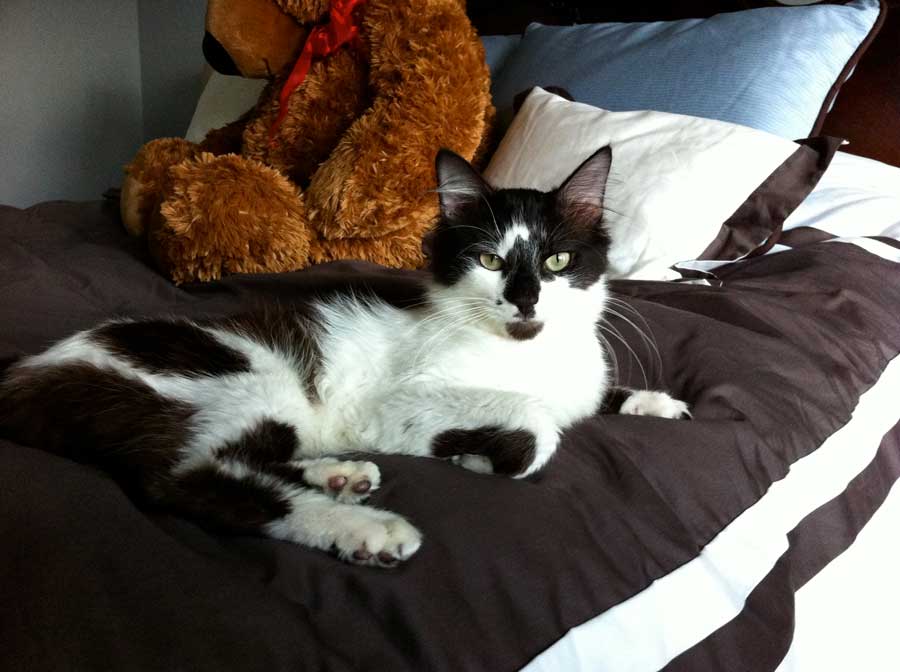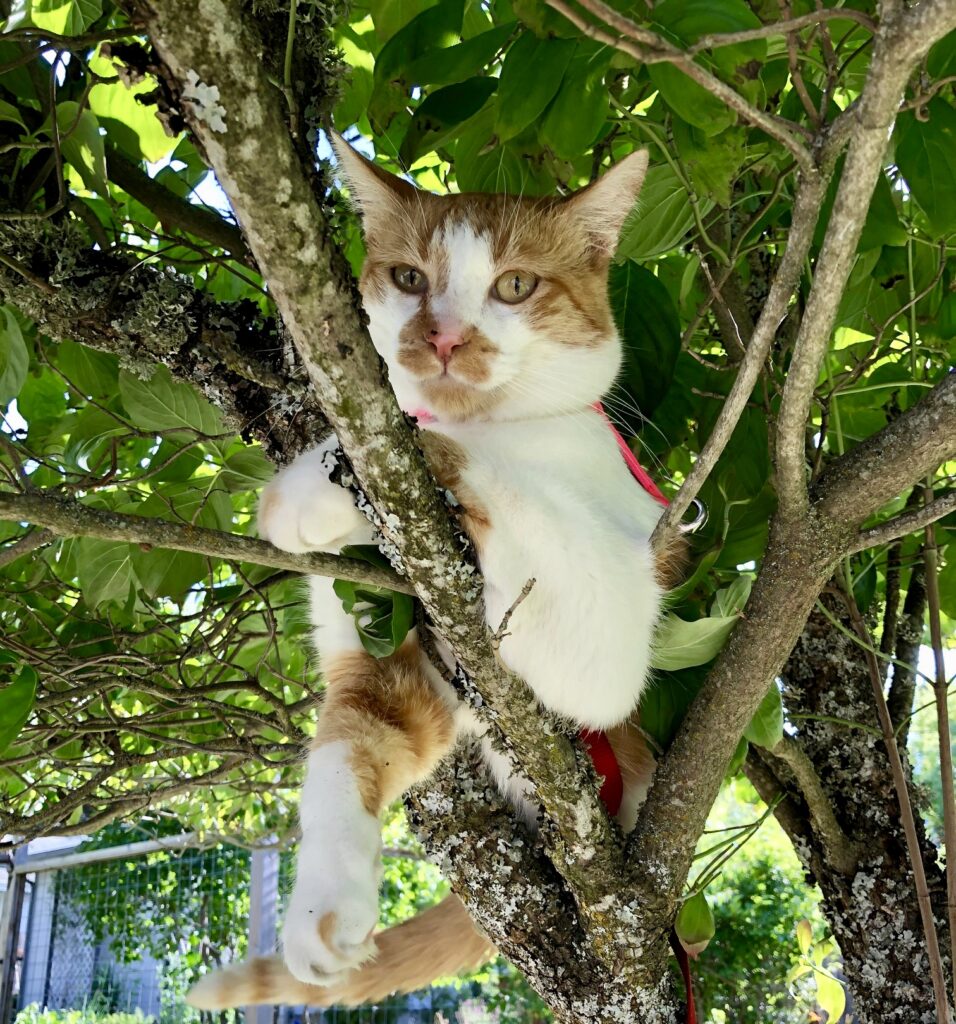Lost cats usually don’t go far — and here’s how to look for them
By Midge Raymond
We see them all the time — flyers with sweet furry faces looking out at us, accompanied by the words “lost cat” and, occasionally, “found cat.” Flyers are one useful way to get the word out about a missing cat — but there are many more, and knowing the secret habits of lost cats can make all the difference.

For indoor cats, the biggest surprise for most humans is that in all the time you’re searching for your lost kitty, he or she is likely right under your nose. A 2018 University of Queensland, Australia, study revealed that the number one most successful way to find a missing cat is by a physical search of the immediate area — this is because the indoor-only cats studied only traveled 54 yards, or roughly a 2.5-house radius, from their homes.
Kat Albrecht, one of the study’s authors, had been a police officer and dog handler before becoming a lost-pet detective and founding the Missing Animal Response Network. The MAR website offers everything from a pet detective directory to details about lost cat behavior. The site notes that frightened indoor-only cats will stay hidden and silent, even if they see or hear you, their beloved human. And they can remain in their hiding places for days or even weeks.
“They stick close because they don’t necessarily know what to do,” says Amanda Linnehan, founder and president of Talent’s Rogue Community Cat Rescue. “People expect that if they call for the cat, the cat’s going to come to them, but they won’t because they’re terrified. Often they won’t make a peep, but generally, they are very, very close.”


So don’t hesitate to crawl under your own house or deck and to comb every inch of your spider-webbed garage and sheds — and, just as important, ask your neighbors for permission to do the same. The MAR site also recommends humane trapping as a way to find a terrified indoor kitty who may not respond but who will eventually get hungry.
If your indoor-outdoor cat goes missing, the search will be different. The 2018 study shows that indoor-outdoor cats travel farther: up to 344 yards, or a 17-house radius, from home, and they usually go missing for different reasons. Instead of escaping out of an open door, they may have been injured, chased from their territory, trapped or inadvertently transported out of the area (cats love to explore cars and delivery vans). Years ago, my husband and I found a starved little cat who was crawling around my parents’ neighborhood, unable to use his back legs. We managed to lure him into a carrier with food and take him to an emergency vet, where we feared the worst; we thought he’d been hit by a car and paralyzed. Yet the vet told us the cat was perfectly healthy; he was hungry and dehydrated, most likely from having been trapped somewhere, unable to move, for as many as two weeks. In this case, Ludwig, as we called him, had a very happy ending; while our flyers did not locate his humans — he may have gotten trapped in a vehicle and ended up far from his original home — he was fostered by lovely neighbors and eventually adopted into a wonderful forever home.

Not every missing housecat is as lucky; many end up in shelters or even in line for spay/neuter. “If a cat gets outside who’s not used to being outside,” says Linnehan, “they may be perceived as feral because they’re so scared they won’t come near you and they won’t let you come near them. So there’s often misrepresentation there just because they’re so terrified.”
What can save the day is a microchip — a tiny, permanent form of identification injected between an animal’s shoulder blades. “Microchips are everything,” says Linnehan. “Because of microchips, cats that people have brought in thinking they’re feral, but they’re really just terrified house cats, get reunited. Or somebody brings in a stray cat from their neighborhood and it’s actually their neighbor’s cat.”
Keeping cats inside, or walking them with a harness and leash, makes it far less likely that they’ll go missing. But even this is no guarantee that they won’t get lost; any cat can get spooked and flee. My husband and I have witnessed two cats escaping from “cat-proof” harnesses while out on walks. We discovered firsthand it’s true they don’t go far — Harlan ran down the street, around the corner and sat waiting for us on the front porch. Teddy’s escape was far scarier — he ran and hid under a neighbor’s deck, three houses away, and it took us a while to find him.
Whether your cats are indoor-only or both indoors and out, always take a few important steps if they go missing. First, check your local shelters and rescues (see sidebar for links). Having a recent photo you can share is essential (as if you need an excuse to take more cat photos!) — use this to make flyers to post around the neighborhood, at local businesses and veterinary offices and to hand to your neighbors. Share the flyer on social media and neighborhood apps.
What to do if you lose or find a cat: Check out these online resources
Friends of the Animals
SoHumane
Jackson County Animal Services
And get your pet microchipped!
FOTAS Affordable Microchip Clinic
One common tactic humans use for lost cats is to put out their litter box in hopes of attracting them back home, which MAR does not recommend, as the scents could instead attract other, more aggressive cats and either scare your own cat farther away or keep them in hiding. MAR recommends using food (which will also attract other cats but likely not territorial ones) as well as a wildlife camera to see who you’re luring with the food.
“Be patient if your cat is lost,” Linnehan advises. “Have a schedule where you’re putting food outside. The cat will smell it, the cat will come eat and eventually you can create a routine and then you should be able to bring the cat back inside. Just be patient and let the cat come to you and try not to force it. A lot of times people give up really fast.”
Again, she reiterates the importance of microchips: “Microchip your cat, and also keep up on the information.” Your vet can provide a microchip, which can be inserted anytime, including at the time of your cat’s spay/neuter surgery, and Friends of the Animals hosts a monthly low-cost vaccination and microchip clinic.
And if you find a cat, take him or her to a veterinary office, shelter or rescue to check for a microchip; this can lead to a quick and happy ending for everyone. “Any vet will do a quick microchip check, and none of the vets charge for that,” says Linnehan. “Get it out there on social media, hang flyers. Make a found report at the Jackson County animal shelter; they have an easy form to fill out online.”
Ashland resident Midge Raymond is co-founder of Ashland Creek Press and author of the novels “Floreana” and “My Last Continent” and co-author of “Devils Island.” Email suggestions and questions for Catty Corner to her at [email protected].





















